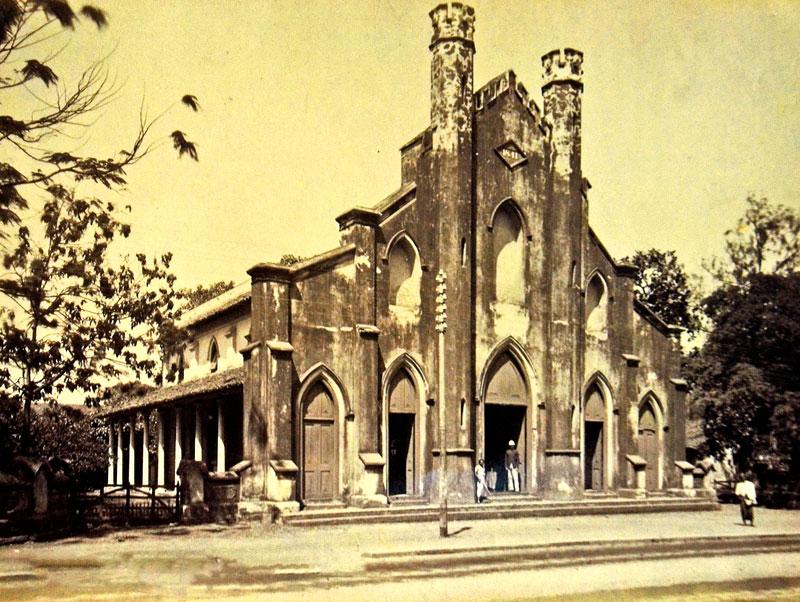
A church is the last place you would find a tribute to a newspaper man, but that is exactly what you will find at the St. Andrew’s Scots Kirk Church, Kollupitiya, located almost opposite the American Center. The Church has a plaque in memory of the Co-Editor of the Ceylon Observer, Donald Ferguson who passed away in Scotland in 1911. The Observer was the oldest English newspaper in Ceylon, having begun publication in 1834. The Ferguson family was closely associated with journalism in Sri Lanka and is also famous for the Ferguson Directory.
 The Church was established during the British Colonial era in Fort in 1841, under the auspices of Queen Victoria of Great Britain and Ireland in the fourth year of her reign. St. Andrew’s Scots Kirk prospered during the colonial and post-colonial periods. With social change in Sri Lanka in the late 20th century, the congregation dwindled, but the church has found a new niche as a Christian place of worship that is “international, interdenominational and open to all”. The congregation is now a mixture of Sri Lankans, expatriates and international visitors, and maintains an English-speaking Protestant form of worship and a keen interest in Christian social service.
The Church was established during the British Colonial era in Fort in 1841, under the auspices of Queen Victoria of Great Britain and Ireland in the fourth year of her reign. St. Andrew’s Scots Kirk prospered during the colonial and post-colonial periods. With social change in Sri Lanka in the late 20th century, the congregation dwindled, but the church has found a new niche as a Christian place of worship that is “international, interdenominational and open to all”. The congregation is now a mixture of Sri Lankans, expatriates and international visitors, and maintains an English-speaking Protestant form of worship and a keen interest in Christian social service.

The cornerstone of the Church, the first in Ceylon was laid on Friday, 26th February 1841. The Pastor of the Church was the first colonial chaplain of Ceylon. It is a Presbyterian church which was built for Scotsmen who were working in Ceylon and required a place of worship.
Scottish ministers were sent from the United Kingdom to minister to these people who had left home to work in the colonies. The Church relocated to Kollupitiya in 1906, where it still stands. The Church of Scotland is a Reformed Church, which was founded by John Knox during the Reformation period in Europe in the 1550s. John Calvin was one of the first reformers in Europe under whose influence John Knox came. Over the next four centuries the Church of Scotland built churches wherever Scottish people were living and working in many parts of the world. Even in Ceylon, there were smaller churches in the plantations in Haputale and Kandy.
Today St. Andrew’s Scots Kirk is part of the International Presbytery. Each church belongs to a Presbytery which provides a supervisory function. Most of the International Presbytery churches are in Europe, and Colombo is only one of three churches outside Europe. St. Andrew’s Scots Kirk is directly under the Church of Scotland and the form of worship and government are Presbyterian.
The Presbytery is accountable to the General Assembly which meets once a year. Representatives from all the presbyteries meet at the general assembly and the Moderator is elected annually for a one year term. It is a flat structure and very democratic as there is a change of personnel at the top every year.
The Colombo church is international and inter-denominational. Inter-denominational means people of all denominations are welcomed, but they retain a Presbyterian identity in their form of worship. People of many denominations worship at St. Andrew’s Scots Kirk, and the form of liturgy is without ceremonial elements and it is similar to that of the Anglican Church. There is no burning of incense, and people stand to sing and sit to pray and it is as simple as that. There is no altar in the Church, and instead there is a table which is called the Communion table. The prayers, hymns and creeds are the same, and services are held once a week. Ample parking is available at the Church premises for the congregation.

The architecture of the Colombo church is Gothic with beautiful stained glass windows and teak pews. There are no definite plans for development of the church grounds, although like many churches they have their own challenges. Given where they are located, they may consider development without altering the character of the Church or the nature of the premises.
Of the notable people who have visited the Colombo Church Queen Elizabeth II visited St. Andrew’s Scots Kirk in 1953. Many Ambassadors and High Commissioners attend the Church. The congregation was predominantly European in the early days, though the Church opened its doors to local people in the late 1960s. The most famous Chaplain was Reverend Andrew Baillie, who served for over 20 years and was instrumental in opening the doors of the church to the locals.
St. Andrew’s Scots Kirk blesses marriages between people of different Christian denominations, and also between Christians and non-Christians. There are many weddings in St. Andrew’s Scots Kirk because many churches do not allow mixed marriages, and people go to this Church to be blessed when their own places of religious worship do not permit it. It is a Church that truly reflects the diversity seen in our country.
(Pix: Wimal Karunathilake)
